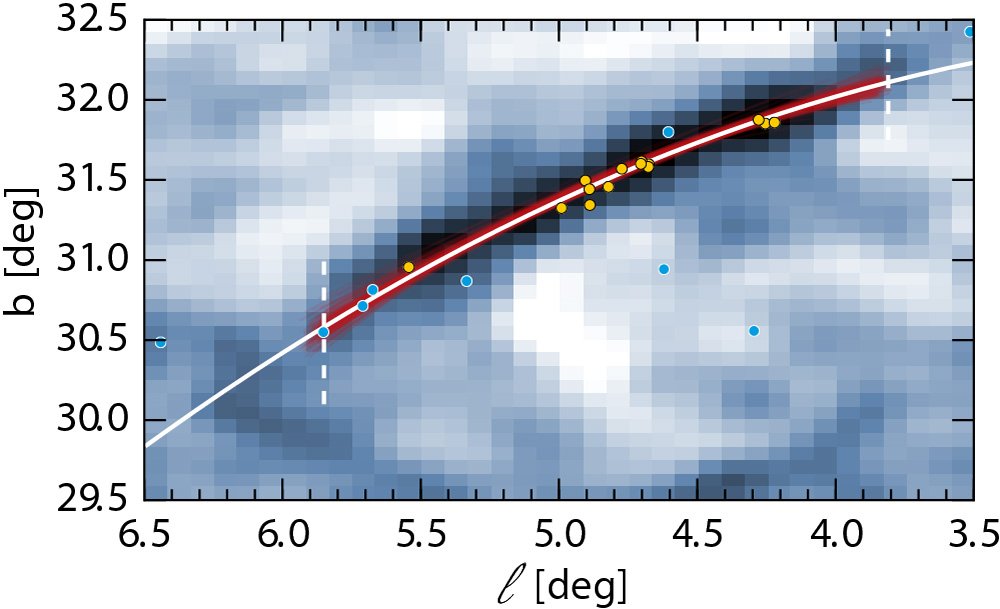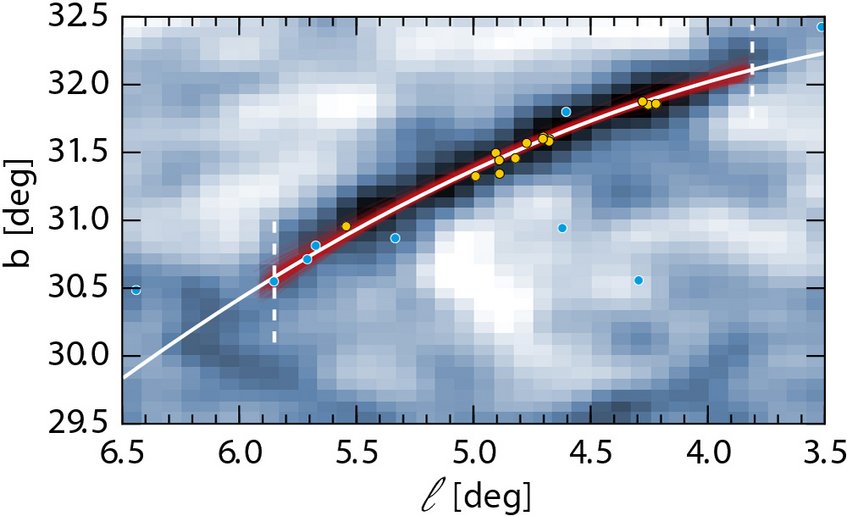
Imaging Surveys

The extent of the Ophiuchus stream in galactic coordinates. The gray-scale map shows the probability-weighted number density of the Ophiuchus stream, smoothed using a 6′-wide Gaussian filter. The thick solid line shows the most probable model (b(ℓ) = 31.37 − 0.80(ℓ − 5) − 0.15(ℓ − 5)2 deg) for the equator of the stream. To illustrate the uncertainty in the most probable model, the thin semi-transparent red lines show 200 models sampled from the posterior distribution. The vertical dashed lines show the likely extent of the stream. The yellow points show the positions of confirmed members, the blue points show candidate BHB stars (probability of being stream members > 80%).
Imaging surveys, such as Pan-STARRS1, observe the sky and measure positions and apparent brightnesses of stars. The data produced by modern imaging surveys are rich in content and enable novel and exciting studies in astronomy.
As an example of such a study, we have used data provided by the Pan-STARRS1 survey to search for stellar streams in the Milky Way. Stellar streams are remnants of accreted Milky Way satellites that were disrupted by tidal forces and stretched into filaments as they orbited in the Galaxy's potential. They are powerful tools for Galactic studies, as their extent and kinematics can be used the constrain the amount and distribution of Dark Matter in the Milky May.
Using Pan-STARRS1 data, we have discovered a new stellar stream in the Ophiuchus constellation, named the Ophiuchus stellar stream. The Ophiuchus stream is located almost straight above the center of the Galaxy, and is currently moving away from us and away from the Galactic plane. Thanks to precise Pan-STARRS1 measurements of brightnesses of stars in the stream, we were able to measure the age of its stars (about 12 billion years), its orientation with respect to us (we are viewing the stream almost end on), and its length (about 1.6 kpc). The stream's length of 1.6 kpc makes it the shortest known stellar stream. For comparison, the next shortest stellar stream, the Pisces stream, is about 4 times longer.
By using the positions of stars observed by Pan-STARRS1 today, and by the Palomar Observatory Sky Survey in 1950s, we were able to precisely measure the movements of stars in direction perpendicular to the line of sight, the so-called proper motion. By combining the proper motions with spectroscopic observations, and by using advanced modeling techniques, we measured the orbital period of the stream to be about 360 million years.
Such a short orbital period came as a great surprise, given the length of the stream (1.6 kpc) and the age of its stars (about 12 billion years). Stellar streams become longer every time they make an orbit around the Galaxy, and thus we would have expected either a longer stream or a longer orbital period, none of which is observed.
Our work on the Ophichus stream continues, and we hope to find many more streams in the Pan-STARRS1 data set. Their characteristics and origin may shine more light on how our Galaxy formed and how it will evolve in the future.
